A) Trade restrictions make all Americans better off.
B) Trade restrictions increase economic efficiency.
C) Trade restrictions are necessary for economic growth.
D) Trade restrictions are sometimes necessary for national security.
F) B) and C)
Correct Answer

verified
Correct Answer
verified
Multiple Choice
The world price of a ton of steel is $650. Before Russia allowed trade in steel, the price of a ton of steel there was $1,000. Once Russia allowed trade in steel with other countries, Russia began
A) exporting steel and the price per ton in Russia decreased to $650.
B) exporting steel and the price per ton in Russia remained at $1,000.
C) importing steel and the price per ton in Russia decreased to $650.
D) importing steel and the price per ton in Russia remained at $1,000.
F) C) and D)
Correct Answer

verified
Correct Answer
verified
Multiple Choice
Scenario 9-2
-For a small country called Boxland, the equation of the domestic demand curve for cardboard is
 where
where

 represents the domestic quantity of cardboard demanded, in tons, and represents the price of a ton of cardboard.
-For Boxland, the equation of the domestic supply curve for cardboard is
represents the domestic quantity of cardboard demanded, in tons, and represents the price of a ton of cardboard.
-For Boxland, the equation of the domestic supply curve for cardboard is
 where
where

 represents the domestic quantity of cardboard supplied, in tons, and again represents the price of a ton of cardboard.
-Refer to Scenario 9-2. Suppose the world price of cardboard is $60. Then, relative to the no-trade situation, international trade in cardboard
represents the domestic quantity of cardboard supplied, in tons, and again represents the price of a ton of cardboard.
-Refer to Scenario 9-2. Suppose the world price of cardboard is $60. Then, relative to the no-trade situation, international trade in cardboard
A) benefits Boxlandian consumers by $750 and harms Boxlandian producers by $660.
B) harms Boxlandian consumers by $736 and harms Boxlandian producers by $598.
C) harms Boxlandian consumers by $704 and benefits Boxlandian producers by $864.
D) harms Boxlandian consumers by $804 and benefits Boxlandian producers by $984.
F) None of the above
Correct Answer

verified
Correct Answer
verified
Multiple Choice
Assume, for Vietnam, that the domestic price of textiles without international trade is higher than the world price of textiles. This suggests that, in the production of textiles,
A) Vietnam has a comparative advantage over other countries and Vietnam will import textiles.
B) Vietnam has a comparative advantage over other countries and Vietnam will export textiles.
C) other countries have a comparative advantage over Vietnam and Vietnam will import textiles.
D) other countries have a comparative advantage over Vietnam and Vietnam will export textiles.
F) B) and C)
Correct Answer

verified
Correct Answer
verified
Multiple Choice
Figure 9-12 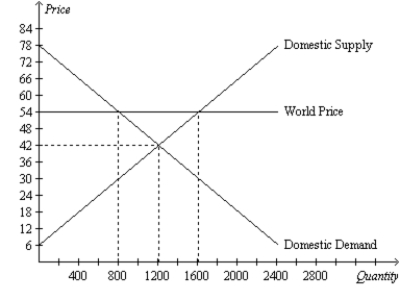 -Refer to Figure 9-12. With trade allowed, this country
-Refer to Figure 9-12. With trade allowed, this country
A) exports 400 units of the good.
B) exports 800 units of the good.
C) imports 400 units of the good.
D) exports 1,600 units of the good.
F) A) and C)
Correct Answer

verified
Correct Answer
verified
True/False
When a country abandons no-trade policies in favor of free-trade policies and becomes an importer of steel, then the domestic price of steel will increase as a result.
B) False
Correct Answer

verified
Correct Answer
verified
Multiple Choice
Figure 9-7. The figure applies to the nation of Wales and the good is cheese. 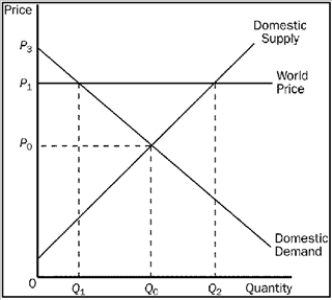 -Refer to Figure 9-7. Which of the following is a valid equation for the gains from trade?
-Refer to Figure 9-7. Which of the following is a valid equation for the gains from trade?
A) Gains from trade = (1/2) (P1 - P0) (Q2 - Q1) .
B) Gains from trade = (1/2) (P1 - P0) (Q2 - Q0)
C) Gains from trade = (1/2) (P1 - P0) (Q1 + Q2) .
D) Gains from trade = (1/2) (Q1) (P3 - P1) .
F) A) and B)
Correct Answer

verified
Correct Answer
verified
Multiple Choice
Figure 9-3. The domestic country is China. 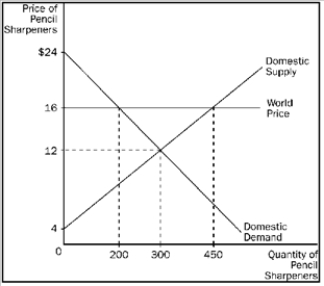 -Refer to Figure 9-3. With no international trade,
-Refer to Figure 9-3. With no international trade,
A) the equilibrium price is $12 and the equilibrium quantity is 300.
B) the equilibrium price is $16 and the equilibrium quantity is 200.
C) the equilibrium price is $16 and the equilibrium quantity is 300.
D) the equilibrium price is $16 and the equilibrium quantity is 450.
F) A) and B)
Correct Answer

verified
Correct Answer
verified
Multiple Choice
The "unfaircompetition" argument might be cited by an American who believes that
A) almost every country has a comparative advantage, relative to the United States, in producing almost all goods.
B) young industries should be protected against foreign competition until they become profitable.
C) the American automobile industry should be protected against Japanese firms that are able to produce automobiles at relatively low cost.
D) the French government's subsidies to French farmers justify restrictions on American imports of French agricultural products.
F) B) and D)
Correct Answer

verified
Correct Answer
verified
Multiple Choice
When a country that imports a particular good imposes an import quota on that good,
A) producer surplus increases and total surplus increases in the market for that good.
B) producer surplus increases and total surplus decreases in the market for that good.
C) producer surplus decreases and total surplus increases in the market for that good.
D) producer surplus decreases and total surplus decreases in the market for that good.
F) A) and C)
Correct Answer

verified
Correct Answer
verified
Multiple Choice
Figure 9-24
The following diagram shows the domestic demand and supply in a market. Assume that the world price in this market is $20 per unit. 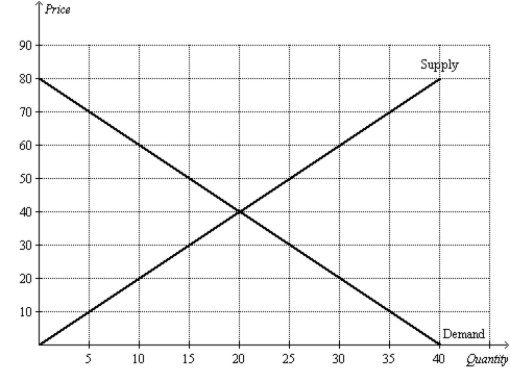 -Refer to Figure 9-24. With free trade, total surplus is
-Refer to Figure 9-24. With free trade, total surplus is
A) $500.
B) $800.
C) $1,000.
D) $1,300.
F) B) and D)
Correct Answer

verified
Correct Answer
verified
Multiple Choice
Assume, for Mexico, that the domestic price of oranges without international trade is lower than the world price of oranges. This suggests that, in the production of oranges,
A) Mexico has a comparative advantage over other countries and Mexico will export oranges.
B) Mexico has a comparative advantage over other countries and Mexico will import oranges.
C) other countries have a comparative advantage over Mexico and Mexico will export oranges.
D) other countries have a comparative advantage over Mexico and Mexico will import oranges.
F) B) and D)
Correct Answer

verified
Correct Answer
verified
Multiple Choice
Figure 9-4. The domestic country is Nicaragua. 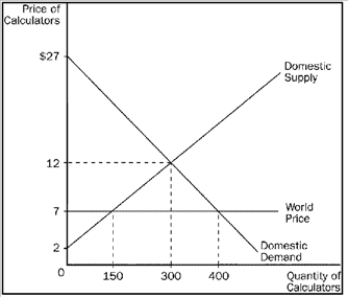 -Refer to Figure 9-4. Which of the following statements is accurate?
-Refer to Figure 9-4. Which of the following statements is accurate?
A) Consumer surplus with trade is $3,200.
B) Producer surplus with trade is $375.
C) The gains from trade amount to $800.
D) The gains from trade are represented on the graph by the area bounded by the points (0, $12) , (300, $12) , (300, $7) and (0, $7) .
F) None of the above
Correct Answer

verified
Correct Answer
verified
Multiple Choice
Trade among nations is ultimately based on
A) absolute advantage.
B) strategic advantage.
C) comparative advantage.
D) technical advantage.
F) A) and B)
Correct Answer

verified
Correct Answer
verified
Multiple Choice
Domestic producers of a good become worse off, and domestic consumers of a good become better off, when a country begins allowing international trade in that good and
A) the country becomes an importer of the good as a result.
B) the world price exceeds the domestic price of the good that prevailed before international trade was allowed.
C) the country in question has a comparative advantage, relative to other countries, in producing the good.
D) total surplus does not change as a result.
F) B) and C)
Correct Answer

verified
Correct Answer
verified
True/False
William and Jamal live in the country of Dumexia. As a result of Dumexia's legalization of international trade in bananas, William becomes better off and Jamal becomes worse off. It follows that William is a seller, and Jamal is a buyer, of bananas.
B) False
Correct Answer

verified
Correct Answer
verified
True/False
If a small country imposes a tariff on an imported good, domestic sellers will gain producer surplus, the government will gain tariff revenue, and domestic consumers will gain consumer surplus.
B) False
Correct Answer

verified
Correct Answer
verified
Multiple Choice
For any country, if the world price of copper is higher than the domestic price of copper without trade, that country should
A) export copper, since that country has a comparative advantage in copper.
B) import copper, since that country has a comparative advantage in copper.
C) neither export nor import copper, since that country cannot gain from trade.
D) neither export nor import copper, since that country already produces copper at a low cost compared to other countries.
F) A) and C)
Correct Answer

verified
Correct Answer
verified
True/False
For a given country, comparing the world price of aluminum and the domestic price of aluminum before trade indicates whether that country's demand for aluminum exceeds the demand for aluminum in other countries.
B) False
Correct Answer

verified
Correct Answer
verified
True/False
If a country allows free trade and imports cars, then it is the case that the gains to domestic producers outweigh the losses to domestic consumers.
B) False
Correct Answer

verified
Correct Answer
verified
Showing 461 - 480 of 493
Related Exams